Loyalty and referral programs are the lifeblood of many ecommerce stores — they serve as both a method of customer retention and acquisition. In fact, almost half (48%) of customers show their loyalty to a brand by joining its loyalty program, and a little over half (52%) do so by recommending the brand to family and friends.
As one of the top ecommerce platforms available, Shopify hosts almost five million online stores. One of the reasons Shopify is so successful as a platform is that it offers store owners a plethora of apps for store integration — including loyalty and referral programs.
What is the impact of having a Shopify referral program? To start, over a quarter (27%) of D2C shoppers cite loyalty programs (which, in many cases, have a referral program built-in) as a leading factor for shopping directly with a brand.
For a real-life example of referral program effectiveness, Yusuf Perens, co-owner of Galen Leather Co, told us that after implementing a referral program, his store generated over $350,000 in sales involving referral codes and drove over 2,000 new customers to the store.
In this guide, we’ll cover everything you need to know about Shopify referral programs, from how they work to how to set them up most effectively.
Understanding Shopify referral programs
A referral program for your Shopify store allows you to incentivize your customers, typically by using discounts or store credit, to recommend your product to their family and friends.
When a customer creates an account to join your referral program, they’ll get a unique referral URL. Sharing it with friends and family automatically generates a code (generally in a popup) that the friend or family member can use in checkout. This code will either give a discount coupon, store credit, or a free product (or another incentive), depending on how you set up your program.
However, Shopify doesn’t have native referral program features, so you’ll need to set up an account with a referral program provider with a Shopify integration, such as LoyaltyLion, and link your Shopify store.
Different types of Shopify referral programs
The ecommerce industry has two main types of referral programs: two-sided and one-sided.
A two-sided referral program rewards the person offering and receiving the referral (with an eligible purchase). A one-sided referral program only rewards the referrer.
Depending on your business goals, you may prefer one of these over the other. For example, a two-sided program is great for rewarding existing customers and maximizing the opportunity to acquire new ones. On the other hand, a one-sided program can offer existing customers better rewards and increase customer retention (since you’re not impacting the margin on acquiring new customers).
Another aspect to consider is how customers interact with your referral program — for example, you might have a widget-based referral program or have a referral program integrated into a loyalty page as part of a wider program.
Widget-based referral programs
A widget-based program simply gives the customer a ‘floating’ widget on your store that they can interact with to see their referral rewards wherever they are on your site:
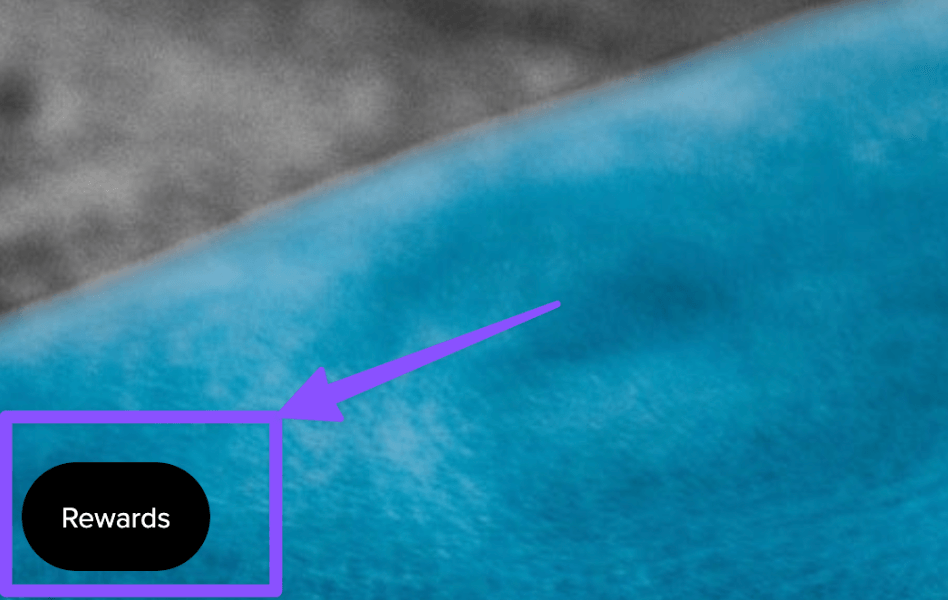
Pros of a widget-based program
There are a few obvious benefits to using a widget-based referral program, including:
– A widget takes up only a small amount of space on the site instead of building a whole page.
– Customers can interact with the program no matter where they are on the site, which also means it’s an always-on reminder of the program.
Cons of a widget-based program
However, you can also flip the above pros into cons:
– Only having a widget means that if a customer has a question about the program, they’ll likely need to refer to a help page about it.
– Having an ‘always-on’ reminder of the program can annoy a few customers who only want to see it when they want to or when it’s relevant (e.g., when they’re ready to start a referral).
A widget-based program can be successful — the owner of Galen Leather uses this approach and achieves the results we mentioned in the introduction. Yusuf also noted that Galen Leather welcomes over 300 new members via their referral program each month using this method.
Referrals within integrated loyalty pages
A referral program that is part of a broader loyalty program and embedded into an integrated loyalty page, on the other hand, gives referrals a ‘home’ within a dedicated area of your site — where customers can navigate when they want to:
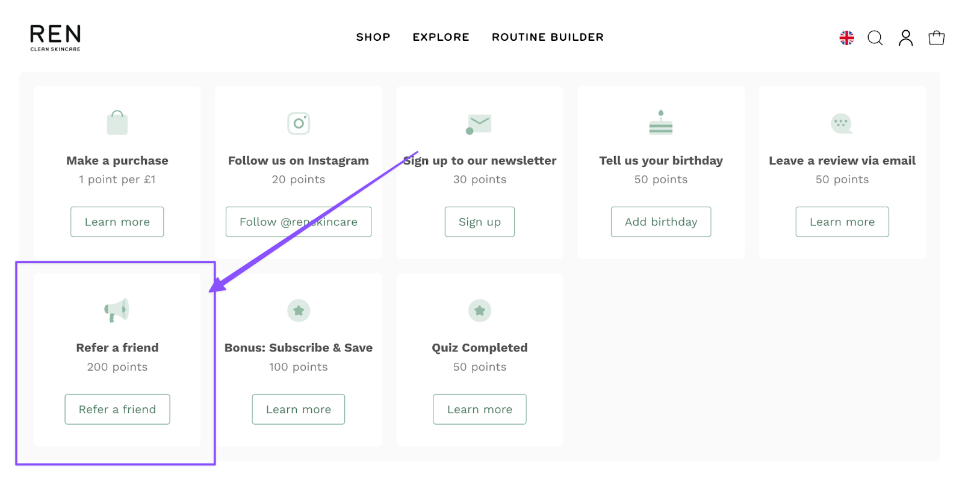
These types of pages, like in the image above, are typically integrated into the “Your Account” section of the store — and, like a widget-based program, also comes with pros and cons.
Pros of housing referrals within integrated loyalty pages
Integrated loyalty pages often help to combat the cons of widget-based programs, for example:
– Since they’re standalone pages, it’s easy to include any FAQs on the page without creating additional help articles in your site’s help center.
– Since the program lives on its own page, the loyalty program can also contribute to SEO efforts.
– Customers can navigate to the loyalty page whenever they want or need to without a constant reminder.
Cons of integrated loyalty pages
An integrated loyalty page is great for having a hub customers can refer to; however:
– Not having frequent reminders of the referral program can mean customers may forget about it and not interact with it as much.
– There’s a minimal chance that seeing all the loyalty information at once can overwhelm the customer, and they decide to ignore it.
As with widget-based programs, referrals embedded into integrated loyalty programs can be highly successful — the folks over at REN Clean Skincare (in the image example above) see 38% of their total revenue coming from their program members, as well as a 68% increase in customer spend from its program members.
Harnessing the power of Shopify referral programs
Although we’ve shown you a few real-life examples of businesses succeeding with referral programs, we can also discuss some of their benefits — backed by research. In this section, as well as showing you the benefits, we’ll also show you how to set up a referral program in your Shopify store to help you reap these benefits.
Potential customers prefer referrals.
While organic discovery via SEO or paid PPC ads are great (though sometimes costly) methods of acquiring new customers, research from Sprout Social reveals that a friend’s recommendation was the most impactful reason for US customers to buy from social channels. This was followed by comments and product reviews, familiarity with the brand, and a significant other’s recommendation.
If you’re in the electronics category of ecommerce, more specific research from Gartner also shows that word-of-mouth recommendations heavily influence 31% of purchases.
As a result of these preferences, customer referrals are often a much more cost-effective solution for customer acquisition.
Referral/loyalty programs increase customer retention.
One older, though seminal paper on the value of referral programs comes from Schmitt, Skiera, and Van den Bulte in the Journal of Marketing. This paper showed that referred customers have a higher contribution margin and are more valuable in both the short and long term.
On top of this, Forbes Advisor research also shows that 69% of consumers rated loyalty programs (which often include built-in referral features) as a top factor influencing brand loyalty.
Referred customers provide a higher customer lifetime value (CLV) and average order value.
Some more research from Schmitt et al. in the American Marketing Association, expanding on their original research, suggested that referred customers generated higher margins and had a 16–25% higher CLV than non-referred customers.
However, at LoyaltyLion, in virtually all of our case studies, businesses that implemented our loyalty program solution (which includes referral features) have seen increases in average spending from members, and in some cases, such as esmi Skin Minerals, even tripling its averages.
How to set up a Shopify referral program step-by-step
For this guide, we’ll be using LoyaltyLion as the example referral program service to set up.
Step 1: Create your referral program account
Assuming you already have a Shopify account and a store up and running, you’ll need to sign up for a referral program provider’s services. Before signing up for LoyaltyLion, you can request a demo to see if you like the look of our services.
Step 2: Set up the program
When you first install the LoyaltyLion program, we’ll ask you to choose your program’s design, the activities that will reward your customers, and how you’ll reward them:
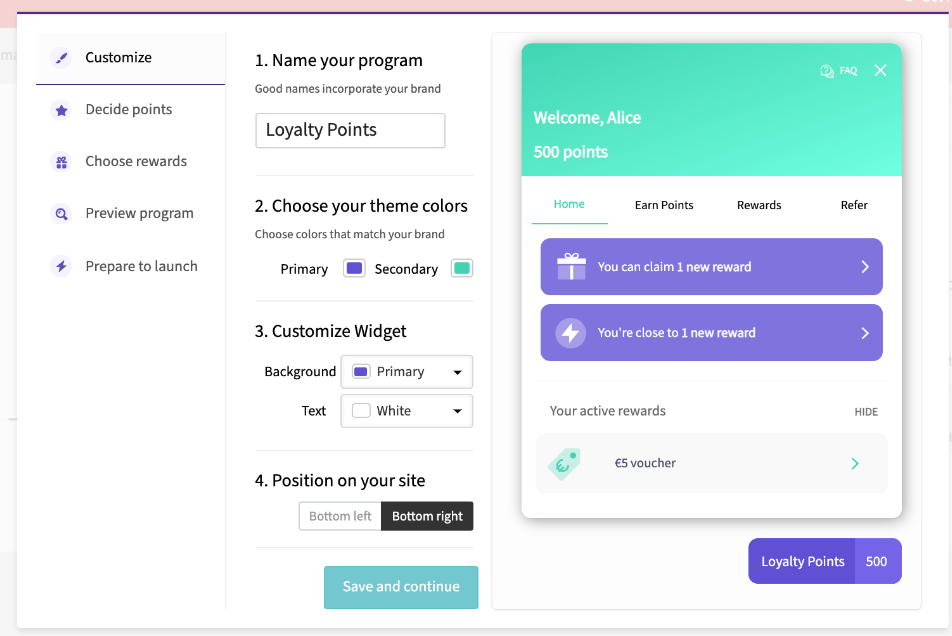
Don’t worry; this initial setup isn’t permanent. You can always change or customize your program later by logging into LoyaltyLion, clicking Manage, then Customize:
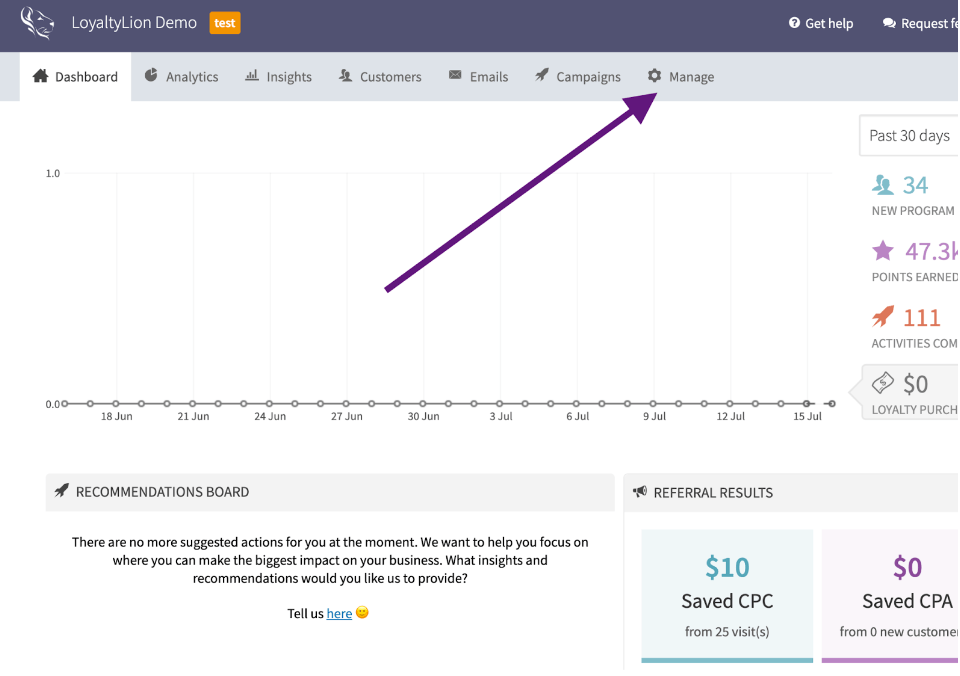
Step 3: Install the LoyaltyLion app on Shopify
Once you’ve set up your LoyaltyLion account and program, you can install the app from the Shopify App Store:
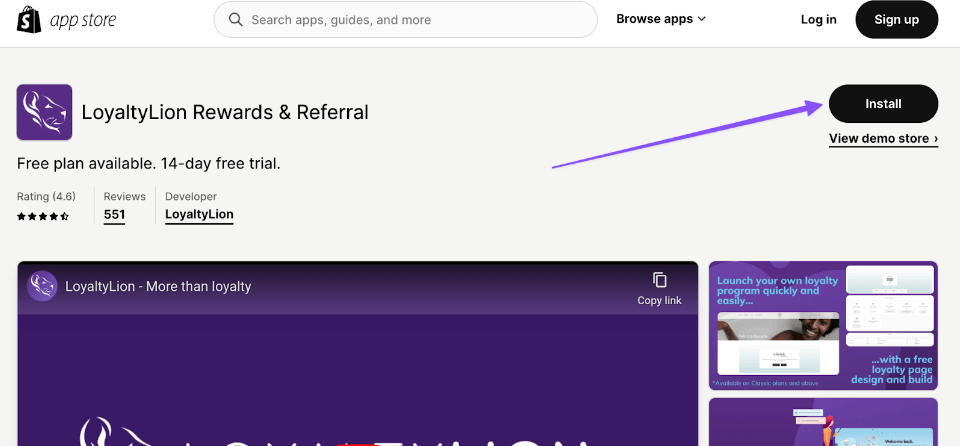
Once you’ve installed the app, you can easily follow the on-screen instructions for connecting your LoyaltyLion account to your Shopify store.
Step 4: Test and Launch your program
If you sign up for the Classic LoyaltyLion account or above, you can test the program before making it live for your customers. In this case, you’ll want to turn off notifications and emails first (you can find detailed instructions for program testing in our help guide here).
After testing your program, it’s ready for launch! Make sure your program is live on your site and shout about it in your store’s social media profiles and emails to attract initial attention.
Choosing the perfect Shopify referral app
In this section, we’ll give an overview of some of the highest-rated referral programs available in the Shopify App Store so that you have a better idea of which one might be best for your business. However, here’s an overview graphic for a quick summary:
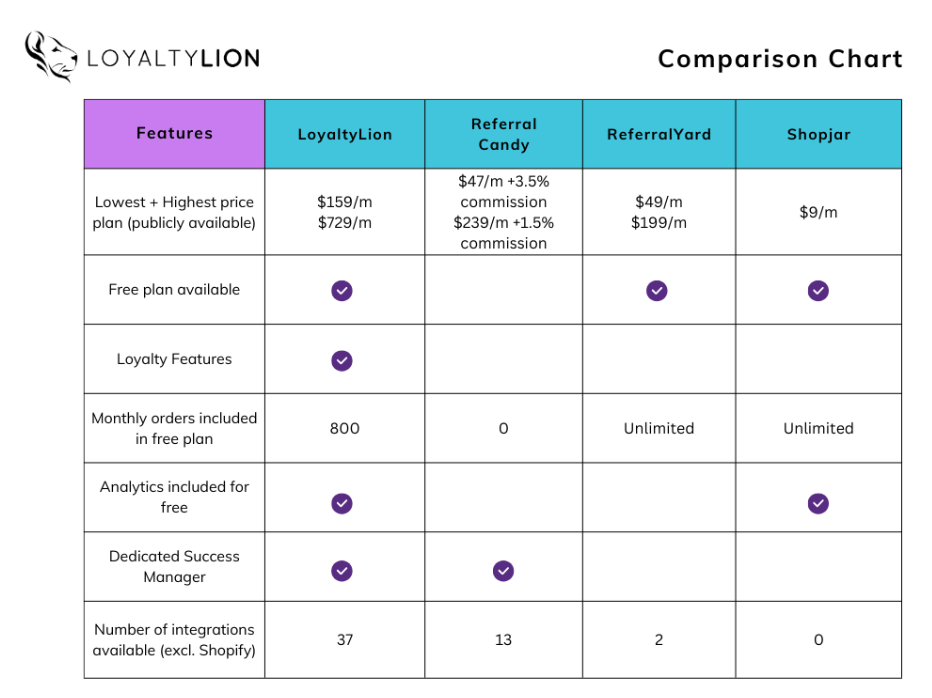
Before diving into the details, there’s one crucial consideration: integrations. If you have an existing tech stack, such as Klaviyo for email marketing or Recharge for subscriptions, you’ll want to make sure your referral solution integrates with them so that you can easily manage the data flow.
In the key features sections below, we’ll indicate paid features only with an asterisk (*).
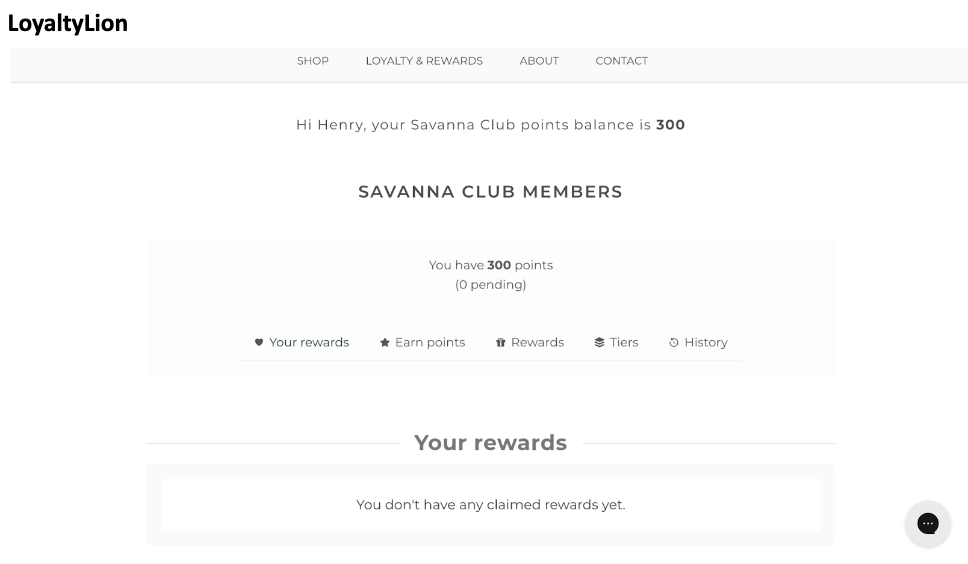
Key features:
– Loyalty solution as well as referral program
– Dedicated integrated and customizable loyalty page
– Unlimited members*
– Dedicated onboarding manager and regular program reviews*
– Customer Value Snapshot analytics
– On-site notifications
– Customizable referral rewards
– Add extra features from only $5/m
– Integrations for email, SMS, helpdesk, reviews, subscriptions, ESP, and more*
Read about our full features and pricing here.
Pricing: Free plan available, Small Business $159/m, Classic $399/m, Advanced $729/m
ReferralCandy
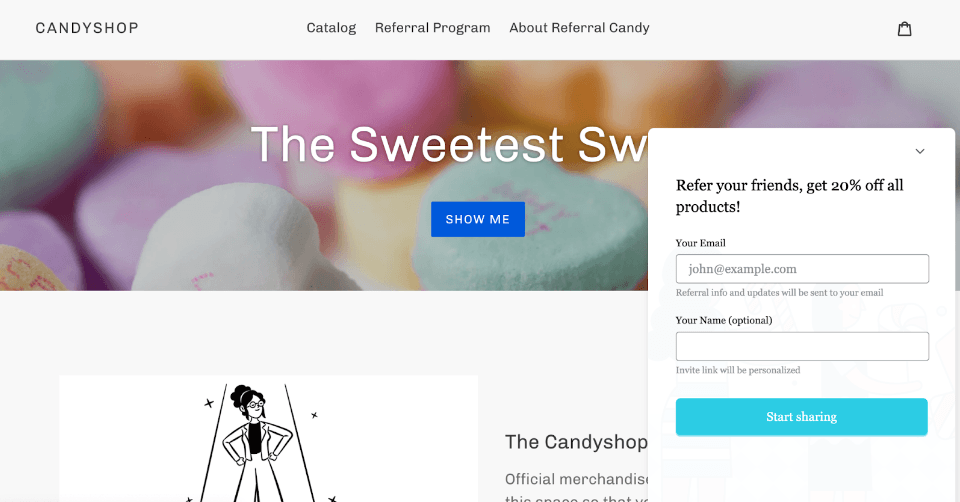
Key features:
– Referral-only solution, no wider loyalty program
– Unlimited customers*
– Integrations for email, subscription, and custom developer integration API*
– Track successful referrals*
– Manage referral fraud*
– Industry benchmark comparison*
– Easy customization*
Full features and pricing are available on ReferralCandy.
Pricing: No free plan, Premium from $47/m +3.5% commission fee, Plus from $239/m +1.5% commission fee, Enterprise plan available (contact for price).
ReferralYard
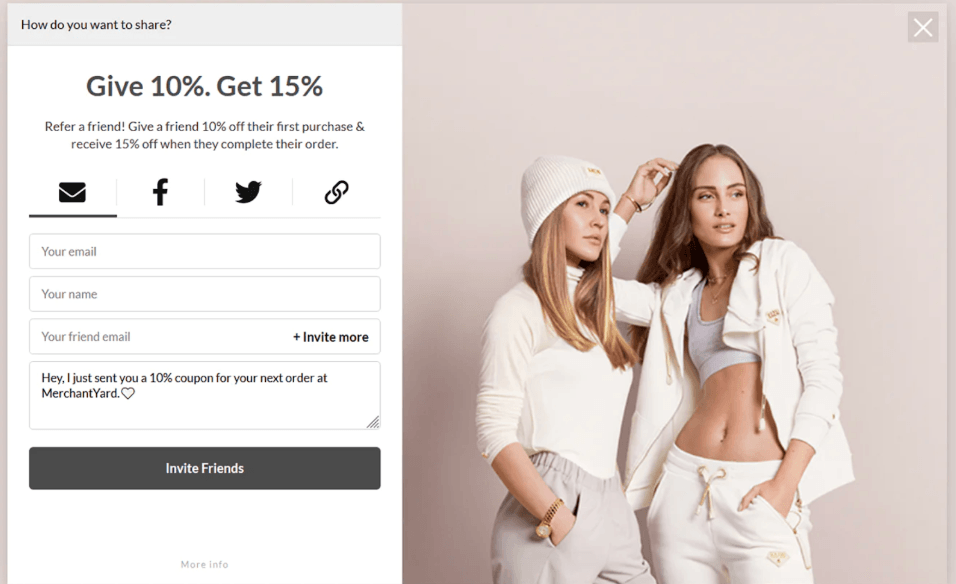
Key features:
– Referral program only (no loyalty solution)
– Unlimited orders and customers
– Integrations with MailChimp and Klaviyo (and custom API)
– Fraud protection*
– Customizable programs*
– SMS sharing*
– Translate to any language
– Referral analytics (Premium plan only)*
– Cash and manual rewards (Premium plan only)*
Pricing: Free plan available, Growth $49/m, Premium $199/m
Shopjar

Key features:
– Referral and affiliate program only, no loyalty features
– Unlimited members/orders
– Landing pages and popups
– Unique referral links
– Referral analytics
– No integrations other than Shopify
– The paid plan gives you access to the affiliate program features
Pricing: Free plan available, Starter $9/m
Optimizing your Shopify referral program for success
Installing a referral program on your store is not a “set-and-forget” activity. No matter which referral program provider you choose, you’ll still need to put in effort to optimize your program for success.
Using your provider’s analytics dashboard, you should regularly review the performance of your program. However, we don’t recommend doing this too frequently (e.g., daily or weekly) as you’ll want to work with longer-term data before making any changes.
For example, when you first launch your program, it’d be normal to see a lot of engagement right away — like your customers are playing with a shiny new toy. However, when the newness wears off, you’ll likely see a slight dip in performance (at first).
Once you’ve noticed a more stable data pattern, you can use your figures as benchmarks to work against for optimization strategies.
For example, suppose your data tells you many customers are sending out referrals, but only a small number of new customers are using referral codes. In that case, you can experiment with your referral offer and see which works best (again, give any changes time to establish a data pattern).
On the flip side, if you notice not many customers are sending out referrals, you should optimize either the messaging of the referral offer itself or your communication around it.
Some referral program providers, such as LoyaltyLion, offer consultative support to help you maximize the potential of your program — make use of these services, especially if it’s your first time using a referral program.
Case studies: Shopify referral success stories
This guide has teased a few case studies to highlight important points. But now let’s get into a few more, in detail, so you can see precisely how setting up a referral program improved real businesses.
Manuka Doctor
From our case study archive, the beauty and personal care brand Manuka Doctor found great success after implementing and optimizing their referral program. The offer they created for referrals was “Give a friend 5% of their first purchase and earn 1,000 points if they spend over £25.”
They built their program to be on-brand (following brand design guidelines) and, in time, found that almost half (47%) of the brand’s revenue started coming from loyal customers.
On top of that, the data showed a little over half (53%) increase in repeat purchase rates — but the real star of the show is the referrals. Manuka Doctor’s data shows an almost 100% conversion rate from referees.
So, what does this case study tell us?
– Having the ability to customize the referral program meant an on-brand experience for customers, which made it more credible and shareable.
– The referral offer is relatively unique and resonates well with Manuka Doctor’s customers — spend time figuring out what your customers would consider a high-quality offer without breaking the margin.
Ofra Cosmetics
Another business using LoyaltyLion to drive successful referrals is Ofra Cosmetics. The folks at this brand know the cosmetics industry is fiercely competitive, and so they needed a way to build relationships with their customers to avoid them turning to competition. To do this, they implemented a loyalty and referral program.
After implementing the program, Ofra Cosmetics saw a 56% increase in repeat purchase rates and a 59% increase in customer spending.
However, once more, the referral program data is the showstopper here — they created a program that rewards customers with 1,000 points per referral and $10 off the first purchase for the referred friend.
This strategy led to more than 201k additional traffic to their store, generating approximately +$183k in additional revenue.
And what does this case study tell us?
– A strong referral program can help you stand out in a competitive industry.
– Using a two-sided referral program strategy is one of the best methods of getting fast results from your program.
As you can see from these case studies, having a referral program on its own can have a positive impact on your business. However, when you use it as part of a wider loyalty program solution, you can see significantly better results for overall store performance.
LoyaltyLion: your partner for referral program success
Building a referral program for your Shopify store can be one of the most impactful strategies for improving several KPIs — from customer retention and acquisition to average order value and customer lifetime value.
What’s more, you don’t even need to know how to code or be a developer to do it. LoyaltyLion provides a no-code, easy-implementation experience
If you’re eager to learn more about mastering customer referral strategies, check out the LoyaltyLion Academy — it’s completely free, and you’ll become the go-to expert for loyalty and referrals in your business in no time.
Otherwise, if you’re itching to get your hands on a loyalty and referral program solution, book a call with one of our loyalty analysts today.





